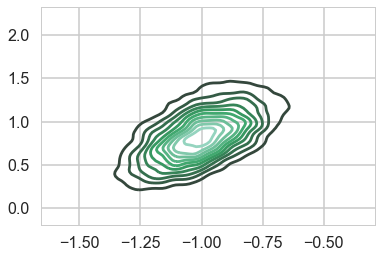Keywords: marginalizing over discretes | mixture model | gaussian mixture model | log-sum-exp trick | pymc3 | Download Notebook
Contents
%matplotlib inline
import numpy as np
import scipy as sp
import matplotlib as mpl
import matplotlib.cm as cm
import matplotlib.pyplot as plt
import pandas as pd
pd.set_option('display.width', 500)
pd.set_option('display.max_columns', 100)
pd.set_option('display.notebook_repr_html', True)
import seaborn as sns
sns.set_style("whitegrid")
sns.set_context("poster")
import pymc3 as pm
import theano.tensor as tt
//anaconda/envs/py3l/lib/python3.6/site-packages/h5py/__init__.py:34: FutureWarning: Conversion of the second argument of issubdtype from `float` to `np.floating` is deprecated. In future, it will be treated as `np.float64 == np.dtype(float).type`.
from ._conv import register_converters as _register_converters
Here is a close set of 2 gaussians.
mu_true = np.array([-1, 1])
sigma_true = np.array([1, 1])
lambda_true = np.array([1/2, 1/2])
n = 100
from scipy.stats import multinomial
# Simulate from each distribution according to mixing proportion psi
z = multinomial.rvs(1, lambda_true, size=n)
data=np.array([np.random.normal(mu_true[i.astype('bool')][0], sigma_true[i.astype('bool')][0]) for i in z])
sns.distplot(data, bins=50);
//anaconda/envs/py3l/lib/python3.6/site-packages/matplotlib/axes/_axes.py:6521: MatplotlibDeprecationWarning:
The 'normed' kwarg was deprecated in Matplotlib 2.1 and will be removed in 3.1. Use 'density' instead.
alternative="'density'", removal="3.1")
//anaconda/envs/py3l/lib/python3.6/site-packages/scipy/stats/stats.py:1713: FutureWarning: Using a non-tuple sequence for multidimensional indexing is deprecated; use `arr[tuple(seq)]` instead of `arr[seq]`. In the future this will be interpreted as an array index, `arr[np.array(seq)]`, which will result either in an error or a different result.
return np.add.reduce(sorted[indexer] * weights, axis=axis) / sumval
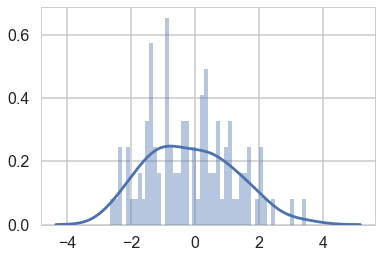
We sample, without imposing any ordering.
with pm.Model() as model1:
p = [1/2, 1/2]
means = pm.Normal('means', mu=0, sd=10, shape=2)
points = pm.NormalMixture('obs', p, mu=means, sd=1, observed=data)
with model1:
trace1 = pm.sample(10000, tune=2000, nuts_kwargs=dict(target_accept=0.95))
Auto-assigning NUTS sampler...
Initializing NUTS using jitter+adapt_diag...
Multiprocess sampling (2 chains in 2 jobs)
NUTS: [means]
Sampling 2 chains: 100%|██████████| 24000/24000 [00:16<00:00, 1475.85draws/s]
The gelman-rubin statistic is larger than 1.4 for some parameters. The sampler did not converge.
The estimated number of effective samples is smaller than 200 for some parameters.
pm.traceplot(trace1, combined=True)
//anaconda/envs/py3l/lib/python3.6/site-packages/matplotlib/axes/_base.py:3604: MatplotlibDeprecationWarning:
The `ymin` argument was deprecated in Matplotlib 3.0 and will be removed in 3.2. Use `bottom` instead.
alternative='`bottom`', obj_type='argument')
array([[<matplotlib.axes._subplots.AxesSubplot object at 0x127df3400>,
<matplotlib.axes._subplots.AxesSubplot object at 0x128187a90>]],
dtype=object)

…and land up in a situation where we get mode-switching in one chain
pm.autocorrplot(trace1);
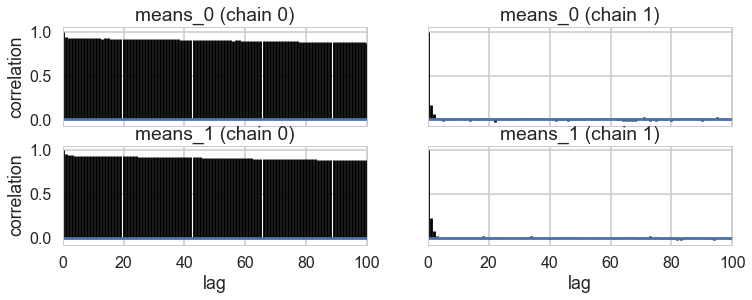
mtrace1 = trace1['means'][::2]
mtrace1.shape
(10000, 2)
np.logspace(-10,2,13)
array([1.e-10, 1.e-09, 1.e-08, 1.e-07, 1.e-06, 1.e-05, 1.e-04, 1.e-03,
1.e-02, 1.e-01, 1.e+00, 1.e+01, 1.e+02])
As a result, the 2D posterior becomes multimodal..our sampler is having identifiability problems which show up in the ridiculously bad autocorrelation.
sns.kdeplot(mtrace1[:,0], mtrace1[:,1], n_levels=np.logspace(-10,1,12));
//anaconda/envs/py3l/lib/python3.6/site-packages/scipy/stats/stats.py:1713: FutureWarning: Using a non-tuple sequence for multidimensional indexing is deprecated; use `arr[tuple(seq)]` instead of `arr[seq]`. In the future this will be interpreted as an array index, `arr[np.array(seq)]`, which will result either in an error or a different result.
return np.add.reduce(sorted[indexer] * weights, axis=axis) / sumval
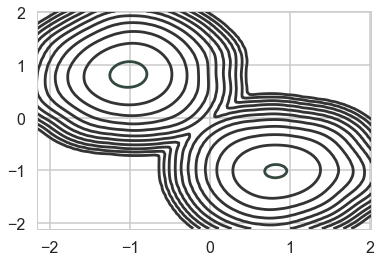
pm.traceplot(trace1);
//anaconda/envs/py3l/lib/python3.6/site-packages/matplotlib/axes/_base.py:3604: MatplotlibDeprecationWarning:
The `ymin` argument was deprecated in Matplotlib 3.0 and will be removed in 3.2. Use `bottom` instead.
alternative='`bottom`', obj_type='argument')

We fix this by adding an ordering transform
import pymc3.distributions.transforms as tr
with pm.Model() as model2:
p = [1/2, 1/2]
means = pm.Normal('means', mu=0, sd=10, shape=2, transform=tr.ordered,
testval=np.array([-1, 1]))
points = pm.NormalMixture('obs', p, mu=means, sd=1, observed=data)
with model2:
trace2 = pm.sample(10000, tune=2000, nuts_kwargs=dict(target_accept=0.95))
Auto-assigning NUTS sampler...
Initializing NUTS using jitter+adapt_diag...
Multiprocess sampling (2 chains in 2 jobs)
NUTS: [means]
Sampling 2 chains: 100%|██████████| 24000/24000 [00:25<00:00, 951.33draws/s]
pm.traceplot(trace2, combined=True)
//anaconda/envs/py3l/lib/python3.6/site-packages/matplotlib/axes/_base.py:3604: MatplotlibDeprecationWarning:
The `ymin` argument was deprecated in Matplotlib 3.0 and will be removed in 3.2. Use `bottom` instead.
alternative='`bottom`', obj_type='argument')
array([[<matplotlib.axes._subplots.AxesSubplot object at 0x135cd8438>,
<matplotlib.axes._subplots.AxesSubplot object at 0x135d0aa58>]],
dtype=object)

…and the multi-modality goes away…
mtrace2 = trace2['means'][::2]
mtrace2.shape
(10000, 2)
sns.kdeplot(mtrace2[:,0], mtrace2[:,1]);
//anaconda/envs/py3l/lib/python3.6/site-packages/scipy/stats/stats.py:1713: FutureWarning: Using a non-tuple sequence for multidimensional indexing is deprecated; use `arr[tuple(seq)]` instead of `arr[seq]`. In the future this will be interpreted as an array index, `arr[np.array(seq)]`, which will result either in an error or a different result.
return np.add.reduce(sorted[indexer] * weights, axis=axis) / sumval

ADVI
advi1 = pm.ADVI(model=model1)
advi1.fit(n=15000)
Average Loss = 180.6: 100%|██████████| 15000/15000 [00:11<00:00, 1363.34it/s]
Finished [100%]: Average Loss = 180.57
<pymc3.variational.approximations.MeanField at 0x127d4deb8>
plt.plot(-advi1.hist, '.-', alpha=0.2)
plt.ylim(-300, -150)
(-300, -150)
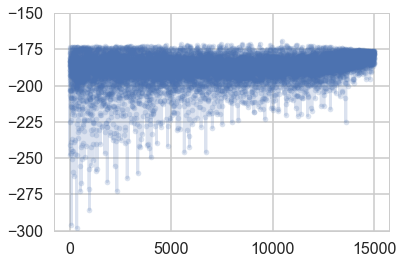
samps1=advi1.approx.sample(10000)
pm.traceplot(samps1);
//anaconda/envs/py3l/lib/python3.6/site-packages/matplotlib/axes/_base.py:3604: MatplotlibDeprecationWarning:
The `ymin` argument was deprecated in Matplotlib 3.0 and will be removed in 3.2. Use `bottom` instead.
alternative='`bottom`', obj_type='argument')

sns.kdeplot(samps1['means'][:,0], samps1['means'][:,1]);
//anaconda/envs/py3l/lib/python3.6/site-packages/scipy/stats/stats.py:1713: FutureWarning: Using a non-tuple sequence for multidimensional indexing is deprecated; use `arr[tuple(seq)]` instead of `arr[seq]`. In the future this will be interpreted as an array index, `arr[np.array(seq)]`, which will result either in an error or a different result.
return np.add.reduce(sorted[indexer] * weights, axis=axis) / sumval
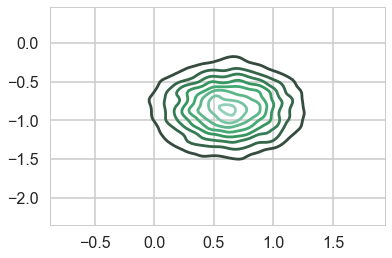
advi2 = pm.ADVI(model=model2)
advi2.fit(n=15000)
Average Loss = 178.08: 100%|██████████| 15000/15000 [00:11<00:00, 1261.75it/s]
Finished [100%]: Average Loss = 178.08
<pymc3.variational.approximations.MeanField at 0x1366a5048>
plt.plot(-advi2.hist, '.-', alpha=0.2)
plt.ylim(-300, -150)
(-300, -150)

samps2=advi2.approx.sample(10000)
pm.traceplot(samps2);
//anaconda/envs/py3l/lib/python3.6/site-packages/matplotlib/axes/_base.py:3604: MatplotlibDeprecationWarning:
The `ymin` argument was deprecated in Matplotlib 3.0 and will be removed in 3.2. Use `bottom` instead.
alternative='`bottom`', obj_type='argument')

sns.kdeplot(samps2['means'][:,0], samps2['means'][:,1]);
//anaconda/envs/py3l/lib/python3.6/site-packages/scipy/stats/stats.py:1713: FutureWarning: Using a non-tuple sequence for multidimensional indexing is deprecated; use `arr[tuple(seq)]` instead of `arr[seq]`. In the future this will be interpreted as an array index, `arr[np.array(seq)]`, which will result either in an error or a different result.
return np.add.reduce(sorted[indexer] * weights, axis=axis) / sumval
